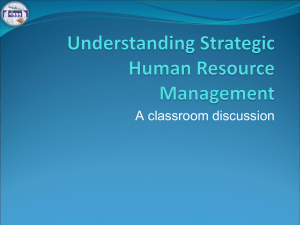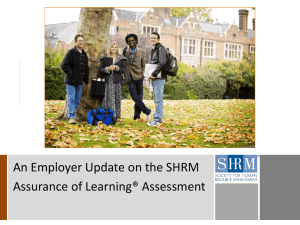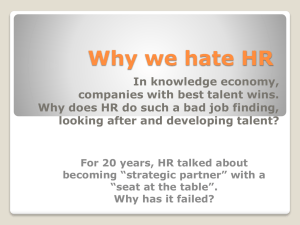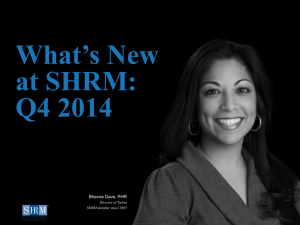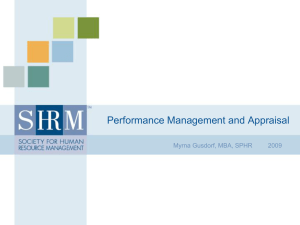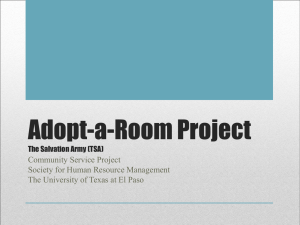Future of HR MA chapter 04
advertisement
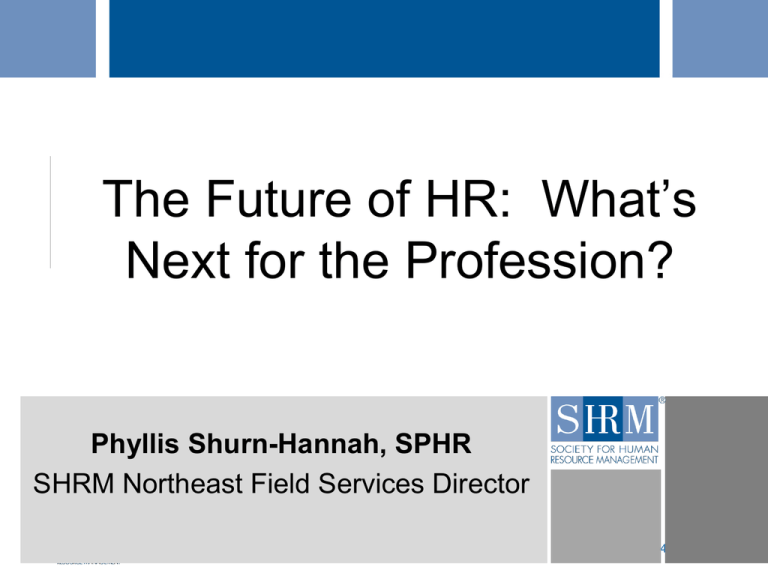
The Future of HR: What’s Next for the Profession? Phyllis Shurn-Hannah, SPHR SHRM Northeast Field Services Director ©SHRM 2014 Howard Schultz on the Role of HR New York Times, Oct. 11, 2010: "People ask me what’s the most important function when you’re starting an organization or setting up the kind of culture and values that are going to endure. The discipline I believe so strongly in is HR… “ ©SHRM 2014 2 Video: “we know next” ©SHRM 2014 3 Knowing what’s next Because people drive change, no one is a better expert on what’s next than HR leaders ©SHRM 2014 4 Today’s Agenda 1. Where we stand today, five years after the recession 2. Key HR challenges at many organizations Low Employee Engagement Stressed, Distrustful Workers Reduced Resources for HR Initiatives Employer Brands in Need of Rebuilding 3. Two-part strategy for turning challenges into opportunities Plan for and Develop Your in-House Talent Build or Rebuild You Employer brand 4. Best Practices Case study of Deloitte LLP ©SHRM 2014 5 Where We Stand Today US Hiring and the economy are slowly picking up A solid 192,000 new jobs were created in March while unemployment remained at 6.7% US GDP grew at 2.5% in 2013 and experts expect slightly higher growth in 2014 HR professionals will need to continue to focus on retaining talent in 2014, rather than recruiting new talent from outside ©SHRM 2014 6 Outlook for HR Professionals Things are starting to look better Job openings posted on SHRM’s HR Jobs web site in 2013 increased by 45% compared to 2009 Also, the U.S. Bureau of Labor Statistics projects an increase of 22% in HR employment by 2018 – compared to a 10.7% increase for all occupations ©SHRM 2014 7 Challenge #1-- Employee Engagement Gallup 2013 State of US Workforce Study: Only 30% of US workforce is engaged 70% of employees are disengaged or actively disengaged 18% of these are actively disengaged, acting out their unhappiness Gallup calculates that low employee engagement costs US businesses $450 billion annually – more than the GDPs of Israel, Portugal, and Singapore ©SHRM 2014 8 Challenge #2 – Stressed Employees 2013 American Psychology Assn survey More than one-third of American workers experience chronic work stress, with low salaries, lack of opportunity for advancement and heavy workloads topping the list of contributing factors Many employees feel stuck, with only 39% citing sufficient opportunities for career advancement and just over half saying they feel valued at work ©SHRM 2014 9 Challenge #3 – Reduced HR Resources HR teams have been hit as hard as other departments by budget cutting Leading a rebound within the confines of smaller HR teams will require greater creativity The bottom line for most HR professionals is “Do more with less” ©SHRM 2014 10 Challenge #4 – Employer Brands Many companies lost their strong employer brands during the recession and have not regained their former strength Rebuilding their employer brand will be key to their business success and ability to convince high performers to stay with their companies ©SHRM 2014 11 Turning Challenges into Opportunities Two-part Strategy #1: Grow from Within #2: Build/Rebuild Your Brand Conduct strategic workforce planning and develop talented employees from within to meet your postrecession and long-term workforce needs Build or rebuild your employer brand to retain and engage your high-performing employees and attract new talent from outside ©SHRM 2014 12 Strategy #1 – Grow from Within Strategic Workforce Planning SWP evaluates future talent needs through systematic workforce assessment This ability to predict and fill future talent needs is critical as companies move towards long-term sustainability HR must make the ROI business case to top management for strategic workforce planning ©SHRM 2014 13 Turnover Costs – Really Cost! Replacing employees from the outside is expensive Skilled employees are still at a premium and will be the basis for competitive advantage as the economy recovers Average cost to replace an employee is at least 150% of the employee’s base salary, according to the Bliss-Gately “Cost-to-Replace Tool” ©SHRM 2014 14 Strategy #1 – Grow from within Example If a company with 1,000 employees and an average base salary of $50,000 lays off 100 employees -- or 10% of its workforce -- it will spend $7.5 million in addition to their salaries to replace them 100 Employees $75,000 $7,500,000 These costs include severance payouts, lost productivity, recruitment and new hire costs, and training ©SHRM 2014 15 Strategy #1 – Grow from Within Strategic Workforce Planning: SHRM-AARP 2012 Poll Joint poll had responses from 430 US HR professionals Aimed to gauge level of SWP with focus on potential retirements by workers aged 50+ 72% of organizations said the loss of boomers’ experience is a current or potential problem, but only 29% had conducted a strategic workforce analysis of the impact of their retiring workers ©SHRM 2014 16 Strategy #1 – Grow from Within • AARP-SHRM free online Workforce Assessment Tool www.aarp.org/workforceassessment www.shrm.org/aarp ©SHRM 2014 17 Strategy #1 – Grow from Within Develop Your Talent Developing talent begins by creating a culture that rewards people emotionally and meets their professional expectations Most employees give top priority to interesting and challenging work and growth opportunities Career and leadership development programs can provide enriching opportunities to improve skills and knowledge ©SHRM 2014 18 Strategy #1 – Grow from Within Workplace Flexibility promotes success, productivity, and balance President Obama at Fortune Magazine’s 2010 Most Powerful Women Summit: “We must change the structure of our workplaces… they must be flexible enough to give workers the ability to be productive.” ©SHRM 2014 19 Strategy #1 – Grow from Within SHRM Workplace Flexibility in the 21st Century Survey ©SHRM 2014 20 Strategy #1 – Grow from Within SHRM / FWI Partnership on Workplace Flexibility The SHRM-FWI partnership, “Moving Work Forward,” aims to help businesses become more successful by transforming the way they view and adopt workplace flexibility By highlighting strategies that enable people to do their best work, “Moving Work Forward” promotes flexible work arrangements that fit the 21st century workforce and create a new competitive advantage for organizations. ©SHRM 2014 21 Strategy #2 – Build Your Employer Brand Why? Goal: Create an image of your organization as a “Great Place to Work” among your stakeholders and the public It helps you grow from within and recruit outside talent: Improves employee retention rates Increases employee motivation/engagement Increases manager satisfaction Increases unsolicited quality job candidates Increases recruiting of younger generations and college students Increases job acceptance rates ©SHRM 2014 22 Strategy #2 – Build Your Employer Brand Communicate your company story and brand via: • Your website • Visual branding on billboards, etc • Print and TV ads • Best Places to Work lists • Chat rooms/forums/blogs • Industry magazines • Social Media • Company buildings and Intranet • Employee testimonials • Job podcasting ©SHRM 2014 23 Case Study: Deloitte LLP Women’s Initiative – Culture of Flexibility Deloitte on “Fortune 100 Best Companies to Work For” list 15 times 20 years ago, It began WIN, its initiative for the advancement and retention of women The creation of WIN marked the beginning of a culture of flexibility at Deloitte. View the Win video at: www.deloitte.com ©SHRM 2014 24 Case Study: Deloitte LLP Talent Strategy Based on Strong Corporate Culture ©SHRM 2014 25 Case Study: Deloitte LLP Brand Building through Social and Online Media ©SHRM 2014 26 Summary -- Takeaways As the economy grows slowly, HR leaders need to shift their focus to strategies for long-term sustainability HR leaders face four key challenges going forward: Low employee engagement Stressed and distrustful employees Reduced budgets for HR initiatives Employer brands in need of rebuilding A two-part strategy can turn these challenges into opportunities Plan and grow in-house capabilities for future workforce needs Build or rebuild your employer brand Emulate Deloitte and seek to make your organization a “Great Place to Work” ©SHRM 2014 27 Final Takeaway – Innovation is Crucial The Future: Personalized products, services for any hand-held device The Future: Personalized products, services for any hand-held device ©SHRM 2014 28 Final Takeaway – Innovation is Crucial Meet Anna and the Workplace of 2020 ©SHRM 2014 29 29 Going Forward Look to SHRM for Support ©SHRM 2014 30 We Need Your Passion and Innovation ©SHRM 2014 31 phannah@shrm.org (Please note that these slides are copyrighted material and may only be distributed to an audience at a SHRM speaker presentation. Further distribution is not allowed, except with permission by SHRM.) ©SHRM 2014 32
